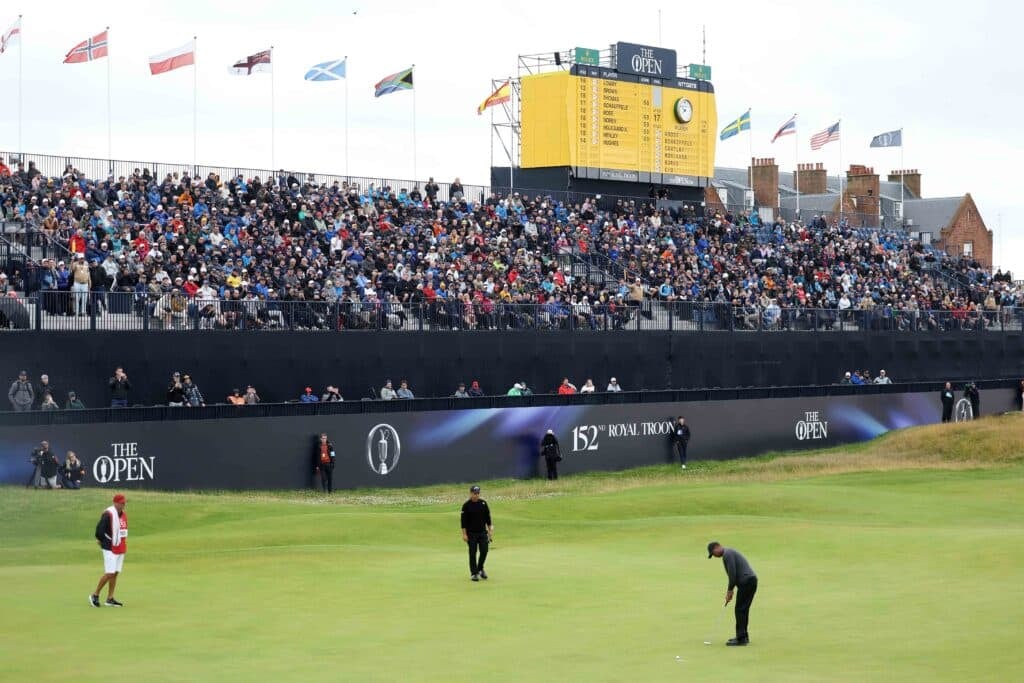Have you seen the size of some of the grandstands at The Open? You can see them from miles away.
It probably isn’t a surprise, then, that they’ve got the potential to draw in a competitor’s ball like a magnet.
Generally speaking, no one expects a player to be swinging into the side of a grandstand, a TV tower, or a scoreboard.
They are classed as temporary immovable obstructions.
But what exactly are they? Well, it’s complicated. Difficult enough, in fact, that the R&A have a brochure explaining the various nuances. It’s got some very helpful graphics and it runs to 16 pages!
Clearly, we’re not going to go through every cough and spit here, but let’s try and break down some key need to knows…

What are Temporary Immovable Obstructions?
They’re not in the main Rules of Golf, for a start. Temporary immovable obstructions (we’re going to call them TIOs from now on) are dealt with by a Local Rule – it’s Model Local Rule F-23 for those who want to look it up.
The definition of a TIO is it’s a “structure that is temporarily added on or next to the course, usually for a particular competition, and is fixed or not readily movable”.
Grandstands are the most obvious examples, but they can also include scoreboards, television towers, and even toilets.
Because they aren’t normally there, they’re not considered to be “part of the challenge of playing the course”.
Where are they found at Royal Troon?
All over the place. The large and smaller grandstands are obvious, as are the TV towers, scoreboards, and pavilions.
But they are also TV hoists, bridge handrails, catering units, metal fencing and elevated cables. There are so many that the Local Rules covering temporary immovable obstructions runs to two pages.
What makes them different from immovable obstructions?
There is nothing to stop you treating a TIO in the same way you would an immovable obstruction. You could take relief under Rule 16 if the obstruction interfered with the lie or your ball, your area of stance or swing, or if your ball touched, was in, or on, it.
Advertisement
But there is a difference when this Local Rule is in play. While you can’t have free relief for line of sight under Rule 16, you can when the TIO is found on a straight line between the ball and hole.

What is line of sight interference for a temporary immovable obstruction?
Obviously, if your ball touches, lies in, on, or under a TIO, or it it interferences with stance and swing, it qualifies anyway. If the obstruction is on your line of sight to the hole – on that straight line we talked about earlier – then you would also get the green light for free relief.
But it also exists in on another occasion and bear with me here because it needs explaining.
Here’s how the R&A and USGA do it: It is if a ball is within one-club length – measured on an equidistant arc from the hole – of a spot where the obstruction would then be on the player’s direct line of sight to the hole. If you’ve watched enough golf on TV, you might have heard of this referred to as “the corridor”.
Can you always get relief – even if you’ve got interference from a temporary immovable obstruction?
No, and we saw a prime example of this during the second round at St Andrews in 2020 when Xander Schauffele found his ball wedged in a gorse bush.
A nearby mini-grandstand was definitely in his line of sight, and would have interfered, but the American didn’t get free relief because it was considered that “playing the ball as it lies would clearly be unreasonable because of something other than the TIO”.
In Xander’s case, the bush.
Advertisement
You’re also not allowed to try and manufacture a free drop.
The rule says “there is no relief when interference exists only because the player chooses a club, type of stance or swing or direction of swing that is clearly unreasonable under the circumstances”.
There’s more too. When it comes to line of sight relief, you’re not going to be able to call for a free drop if the TIO is miles away, or to be more technical “it is clearly unreasonable for a player to play the ball far enough that the ball will reach the TIO”.
How do I take relief?
We’re just going to look at balls in the general area here – take a peek at the Model Local Rule for what to do in bunkers or penalty areas.
If you had interference from, let’s say a scoreboard, you’d find the nearest point of complete relief where “both physical and line of sight relief no longer exist”. That’s your reference point. You then have a one club-length relief area from which to drop – no nearer the hole, of course.
It’s worth saying again – there has to be complete relief from both physical and line of sight interference by the TIO.

Why are drop zones used?
If you’re wedged in a grandstand, have a look down into the turf or rough below and you might see a little white circle.
These are drop zones. They can be either optional, or mandatory, and they essentially speed up the process. If they are compulsory, a player has to use them to take relief.
There are examples of both at Royal Troon. The entrance gate at the 9th hole, with its tent, flagpoles and fencing, has an optional drop zone, while players who have physical interference from the grandstand on the left of the 18th hole must drop a ball in a DZ nearest to where the ball originally lay.
Advertisement
In this case, that nearest dropping zone “may be nearer the hole”.
Now have your say
Do you agree with these rules on temporary immovable obstructions? Let me know your thoughts by leaving me a comment on X.
Advertisement
